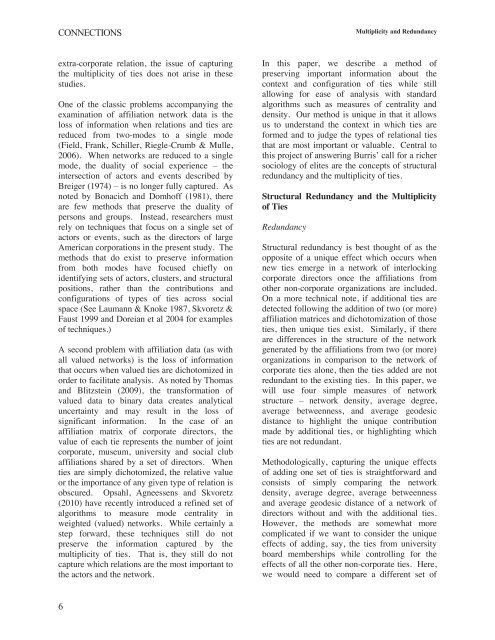CONNECTIONS - INSNA
CONNECTIONS - INSNA
CONNECTIONS - INSNA
You also want an ePaper? Increase the reach of your titles
YUMPU automatically turns print PDFs into web optimized ePapers that Google loves.
<strong>CONNECTIONS</strong><br />
Multiplicity and Redundancy<br />
extra-corporate relation, the issue of capturing<br />
the multiplicity of ties does not arise in these<br />
studies.<br />
One of the classic problems accompanying the<br />
examination of affiliation network data is the<br />
loss of information when relations and ties are<br />
reduced from two-modes to a single mode<br />
(Field, Frank, Schiller, Riegle-Crumb & Mulle,<br />
2006). When networks are reduced to a single<br />
mode, the duality of social experience – the<br />
intersection of actors and events described by<br />
Breiger (1974) – is no longer fully captured. As<br />
noted by Bonacich and Domhoff (1981), there<br />
are few methods that preserve the duality of<br />
persons and groups. Instead, researchers must<br />
rely on techniques that focus on a single set of<br />
actors or events, such as the directors of large<br />
American corporations in the present study. The<br />
methods that do exist to preserve information<br />
from both modes have focused chiefly on<br />
identifying sets of actors, clusters, and structural<br />
positions, rather than the contributions and<br />
configurations of types of ties across social<br />
space (See Laumann & Knoke 1987, Skvoretz &<br />
Faust 1999 and Doreian et al 2004 for examples<br />
of techniques.)<br />
A second problem with affiliation data (as with<br />
all valued networks) is the loss of information<br />
that occurs when valued ties are dichotomized in<br />
order to facilitate analysis. As noted by Thomas<br />
and Blitzstein (2009), the transformation of<br />
valued data to binary data creates analytical<br />
uncertainty and may result in the loss of<br />
significant information. In the case of an<br />
affiliation matrix of corporate directors, the<br />
value of each tie represents the number of joint<br />
corporate, museum, university and social club<br />
affiliations shared by a set of directors. When<br />
ties are simply dichotomized, the relative value<br />
or the importance of any given type of relation is<br />
obscured. Opsahl, Agneessens and Skvoretz<br />
(2010) have recently introduced a refined set of<br />
algorithms to measure mode centrality in<br />
weighted (valued) networks. While certainly a<br />
step forward, these techniques still do not<br />
preserve the information captured by the<br />
multiplicity of ties. That is, they still do not<br />
capture which relations are the most important to<br />
the actors and the network.<br />
In this paper, we describe a method of<br />
preserving important information about the<br />
context and configuration of ties while still<br />
allowing for ease of analysis with standard<br />
algorithms such as measures of centrality and<br />
density. Our method is unique in that it allows<br />
us to understand the context in which ties are<br />
formed and to judge the types of relational ties<br />
that are most important or valuable. Central to<br />
this project of answering Burris’ call for a richer<br />
sociology of elites are the concepts of structural<br />
redundancy and the multiplicity of ties.<br />
Structural Redundancy and the Multiplicity<br />
of Ties<br />
Redundancy<br />
Structural redundancy is best thought of as the<br />
opposite of a unique effect which occurs when<br />
new ties emerge in a network of interlocking<br />
corporate directors once the affiliations from<br />
other non-corporate organizations are included.<br />
On a more technical note, if additional ties are<br />
detected following the addition of two (or more)<br />
affiliation matrices and dichotomization of those<br />
ties, then unique ties exist. Similarly, if there<br />
are differences in the structure of the network<br />
generated by the affiliations from two (or more)<br />
organizations in comparison to the network of<br />
corporate ties alone, then the ties added are not<br />
redundant to the existing ties. In this paper, we<br />
will use four simple measures of network<br />
structure – network density, average degree,<br />
average betweenness, and average geodesic<br />
distance to highlight the unique contribution<br />
made by additional ties, or highlighting which<br />
ties are not redundant.<br />
Methodologically, capturing the unique effects<br />
of adding one set of ties is straightforward and<br />
consists of simply comparing the network<br />
density, average degree, average betweenness<br />
and average geodesic distance of a network of<br />
directors without and with the additional ties.<br />
However, the methods are somewhat more<br />
complicated if we want to consider the unique<br />
effects of adding, say, the ties from university<br />
board memberships while controlling for the<br />
effects of all the other non-corporate ties. Here,<br />
we would need to compare a different set of<br />
6
















